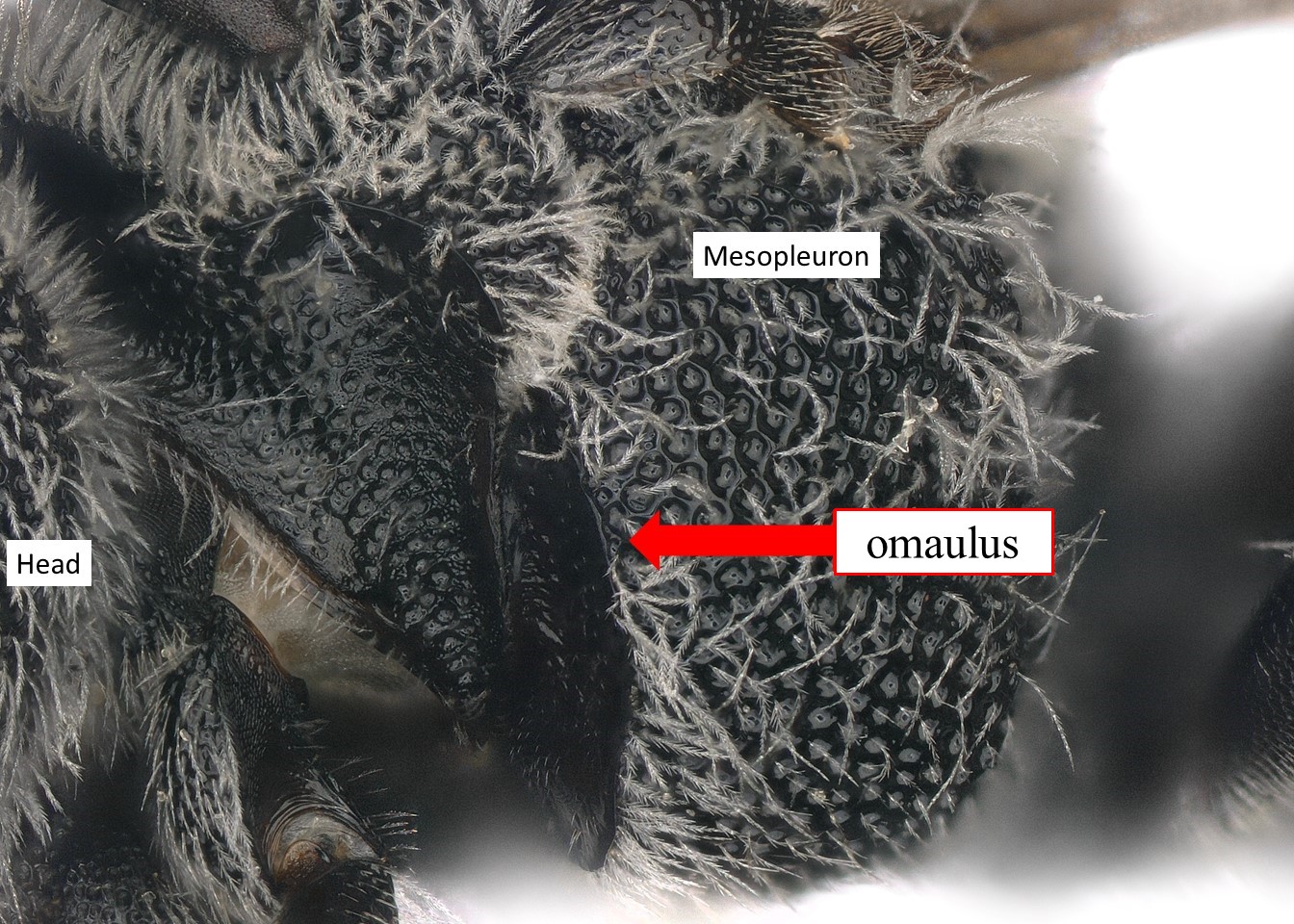Family: Megachilidae
Subfamily: Megachilinae
Tribe: Anthidiini
Genus: Paranthidium Cockerell and Cockerell, 1901
Subgenera: Paranthidium, Rapanthidium
Common name: none
Paranthidium are bees with robust bodies that range in body length from 7.5–11.0 mm (Michener 2007Michener 2007:
Michener, C.D. 2007. The Bees of the World (2nd ed.). Johns Hopkins University Press, Baltimore and London, 953 pp.). They are nonmetallic and have black or brown integumentintegument:
a tough, protective outer layer
with white to yellow abdominal, thoracic, or facial patterns (Michener 2007Michener 2007:
Michener, C.D. 2007. The Bees of the World (2nd ed.). Johns Hopkins University Press, Baltimore and London, 953 pp.). Some species have color patterning that is similar to that of a hornet (Wilson and Carril 2016Wilson and Carril 2016:
Wilson, J.S. and O.M. Carril. 2016. The Bees in Your Backyard: A Guide to North Americarsquo;s Bees. Princeton University Press, Princeton and Oxford, 288 pp.). The presence of pollen-collecting hairs on the female abdomen and other characters make them easy to identify as a bee on close inspection.
Paranthidium contains approximately 8 species in 2 subgenera worldwide. Paranthidium jugatorium, occurs in the U.S. and is rare or absent in extreme southern Canada (Michener 2007Michener 2007:
Michener, C.D. 2007. The Bees of the World (2nd ed.). Johns Hopkins University Press, Baltimore and London, 953 pp.; Wilson and Carril 2016Wilson and Carril 2016:
Wilson, J.S. and O.M. Carril. 2016. The Bees in Your Backyard: A Guide to North Americarsquo;s Bees. Princeton University Press, Princeton and Oxford, 288 pp.). Two species are undescribed (Michener 2007Michener 2007:
Michener, C.D. 2007. The Bees of the World (2nd ed.). Johns Hopkins University Press, Baltimore and London, 953 pp.).
(modified from Michener 2007Michener 2007:
Michener, C.D. 2007. The Bees of the World (2nd ed.). Johns Hopkins University Press, Baltimore and London, 953 pp.)
 with laterallateral:
with laterallateral: trilobed, the median lobe always larger than the laterallateral:
trilobed, the median lobe always larger than the laterallateral:Paranthidium may be confused with Dianthidium due to similar size, shape, and coloration, but can be easily distinguished because Paranthidium lacks omaularomaular:
angle between anterior and lateral surfaces of mesepisternum
 and preoccipital carinacarina:
and preoccipital carinacarina:
a clearly defined ridge or keel, not necessarily high or acute; usually appears on bees as simply a raised line
(Michener 2007Michener 2007:
Michener, C.D. 2007. The Bees of the World (2nd ed.). Johns Hopkins University Press, Baltimore and London, 953 pp.).
There are no known invasives.
Paranthidium is endemic to the Western Hemisphere, and ranges from the U.S. south to Panama (Michener 2007Michener 2007:
Michener, C.D. 2007. The Bees of the World (2nd ed.). Johns Hopkins University Press, Baltimore and London, 953 pp.). The only species that occurs in the U.S., is P. jugatorium which occurs from the Atlantic Coast into the midwestern and southwestern U.S. This species has been further divided into four subspecies (Wilson and Carril 2016Wilson and Carril 2016:
Wilson, J.S. and O.M. Carril. 2016. The Bees in Your Backyard: A Guide to North Americarsquo;s Bees. Princeton University Press, Princeton and Oxford, 288 pp.). Paranthidium jugatorium jugatorium occurs from New York to the Midwest; P. jugatorium lepidum occurs in Kentucky and Virginia, south to Georgia, with records in northern Florida; P. jugatorium butleri occurs in Arizona; and P. jugatorium perpictum occurs in Colorado, New Mexico, and Arizona (Wilson and Carril 2016Wilson and Carril 2016:
Wilson, J.S. and O.M. Carril. 2016. The Bees in Your Backyard: A Guide to North Americarsquo;s Bees. Princeton University Press, Princeton and Oxford, 288 pp.). The remaining species in the genus occur in Mexico and Central America (Michener 2007Michener 2007:
Michener, C.D. 2007. The Bees of the World (2nd ed.). Johns Hopkins University Press, Baltimore and London, 953 pp.).
Distribution map generated by Discover Life -- click on map for details, credits, and terms of use.